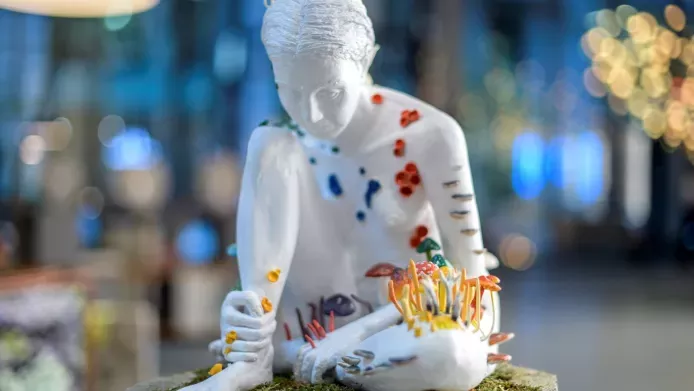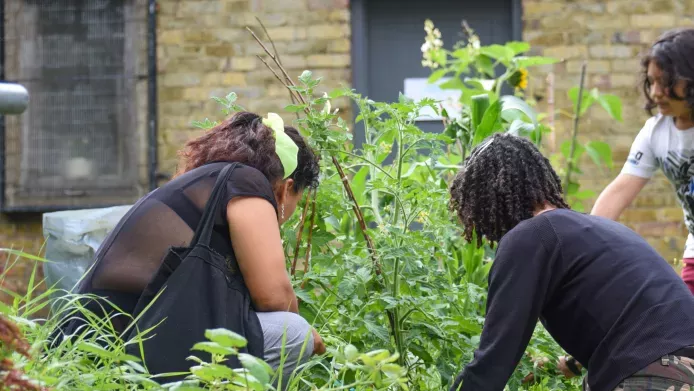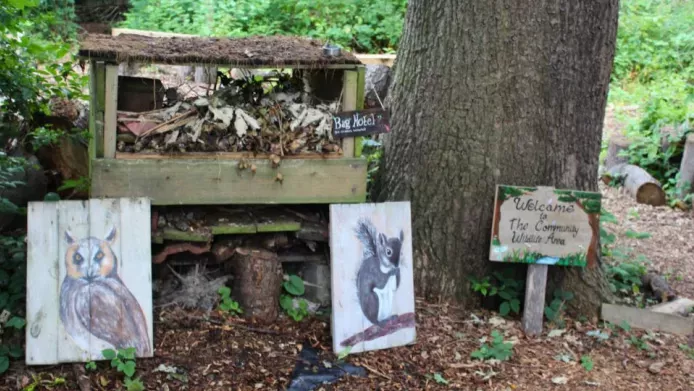Broomhouse Community Growing Association (BCGA) started in 2019, fostering community growing in Broomhouse, an Edinburgh estate made up largely of local authority housing. We spoke to project leader, Faith, about how BCGA is bringing locals together and improving biodiversity through native planting.
The group grew from a partnership between the residents, Edible Estates, and the local community centre. We have previously developed a 400m2 community garden which grows food for participants, the community cafe and residents. When we ran out of space in the garden we applied to join the Grow Wild Community Programme, to create a new community orchard and wildlife area.
The new site sits in the middle of three tenement buildings, a car park, railway line and a road. It was overgrown and accumulating litter. We wanted to improve the biodiversity of the space with native plants and wildflowers, to create a beautiful space where community groups and local people could gather.

‘I live directly behind the first community garden site. When I heard about the project in 2019, I was worried about parking and water drainage to my garden and house so I went to the meeting about it at the community centre and objected. But I never left... I've never done gardening in my life, but I like building things, so when I saw the polytunnel I had to build I got involved. It basically got me through COVID.’
Mark - BCGA volunteer
Early in the year weather conditions meant the planting area was really dry, so we planted the wildflowers really late in spring after waiting to prepare the ground. We planted three native wildflower areas. One has come up beautifully, while in another, nothing we sowed grew (only what was there before). Each area was sown with a slightly different wildflower mix – for example, we used a Scottish woodland mix for the shady area, which included species such as wood sage (Teucrium scorodinia), herb bennet (Geum urbanum) and meadowsweet (Filipendula ulmaria).

There are loads of insects in the space now and it’s certainly a lot healthier than this time last year. Some of the plants that were here before were already beneficial to biodiversity, such as a huge ivy bush and elder, so we’ve left them. We are going to make a path through the wildflowers, to encourage residents to benefit from the area. We have got the material already, but a lot of the area for the path is overrun with dock leaves, so we might hire a digger to do the prep work so we can get going.
We’ve also planted heritage varieties of fruit trees including apple, pear and plum to create our orchard. We got the trees from Scottish Fruit Trees, who gave us loads of advice about which varieties to plant and how to plant them. For the apple and pear trees we were advised about two options: have just a few trees at full size, or plant more of them close together in avenues to keep them two metres high. We chose to plant them close together, to ensure they never get too tall for the public to pick fruit from the ground, and most of the trees have thrived.

We used sheep's wool in the soil, which I got for free from a farmer nearby. We’ve also got two big water tanks (1000L) that store water from the drainpipe of a shed in the neighbouring garden, which saves a lot of time lugging water to the site to keep the trees alive.
 Sheep's wool in the soil
Sheep's wool in the soil
Soon we will get native hedges from the Woodland Trust, which we will plant along the border of the orchard. We’re also going to make a small pond out of a big old sink that one of our volunteers found. This is going to be a long project, we had an idea we were going to get it done in a year, but it will likely be a couple of years now, because there's so much to do.
Luckily, we have a great team of volunteers: there's still four volunteers who were initially here in 2019 when the first community garden began. There were about ten at that time, then the numbers decreased, so we did a leaflet drop in the local area and that's how we met our volunteer Neil. He hand sieves all of our compost to filter out any debris – about two tonnes twice a year.
‘I saw a leaflet with information about the community garden. I took early retirement, and hadn’t done anything for about a year, so I thought that’d be good to do. I enjoyed it and I kept coming back.’
Neil - BCGA volunteer
Quite a few people come and join the sessions on Wednesdays and Saturdays. During lockdown we were allowed to carry on, with precautions. At a time when there weren’t many things you could do outside the home, we were grateful we could still garden.
I assumed volunteers joined for the vegetables (we give a lot to the community hub kitchen), but that's not the case. People mainly come to the garden because they enjoy the company, being together, being outside and getting to know people – we have twelve dedicated volunteers now and they are good friends.
Grow Wild's Community Programme

Previous projects


